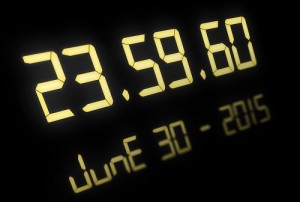The Coordinated Universal Time (UTC) time standard, based on atomic clocks, is widely used for international timekeeping and as the reference for time in most countries. UTC is the basis of legal time for most of the world.
UTC must be adjusted at irregular intervals to maintain its correlation to mean solar time due to irregularities in the Earth’s rotation. These adjustments, called leap seconds, are pre-determined.
The last leap second occured on 30 June 2015 at 23:59:59 UTC. Specifically, a positive leap second was inserted between second 23:59:59 of 30 June and second 00:00:00 of 1 July. This extra second is displayed on UTC clocks as 23:59:60.
Insertion of each UTC leap second is usually decided several months in advance (in this case was in January 2015) by the International Earth Rotation and Reference Systems Service (IERS), when needed to ensure that the difference between the UTC and the mean solar time standard (UT1) readings will remain within +/- 0.9 second.
Climatic, geological, and cosmic events affect the Earth’s irregular rotation speed. This irregular motion of the earth’s rotation rate is accounted for by the introduction of leap seconds. Without such a correction, time computed by Earth’s rotation (UT1) drifts away from UTC. Leap seconds are irregularly spaced and unpredictable. In fact it is possible that leap seconds may be either positive or negative, but so far, all leap seconds have been positive.
In 1972, the present definition of time keeping was adopted that include the insertion of leap second so that the broadcast UTC seconds could be made exactly equal to the standard International System (SI) second, while still maintaining the UTC time of day and changes of UTC date synchronized with those of UT1. By then, the UTC clock was already 10 seconds behind TAI, which had been synchronized with UT1 in 1958, but had been counting true SI seconds since then.
After 1972, both clocks have been ticking in SI seconds, so the difference between their readouts at any time is 10 seconds plus the total number of leap seconds that have been applied to UTC.
How did the leap second affect GNSS receivers?
This update is pushed out to GNSS receivers to ensure that systems relying on GNSS timing information remain up to date on the latest UTC time. It’s down to the GNSS receiver’s system software to correctly interpret this adjustment data and apply the leap second at the correct time. But some models of receiver applied the correction too early.

